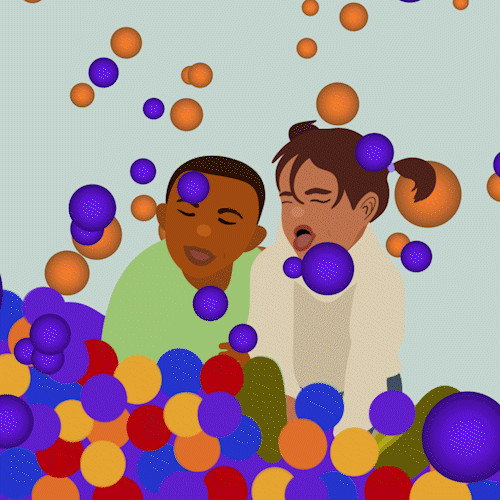By: James Wallert
In April of 2018, I brought five high school students to an early morning event sponsored by the New York State Education Department. 200 educational leaders representing 27 school districts from all across the state were there to begin the process of creating integration plans for their districts. New York State has the most racially and socio-economically segregated schools in the nation and New York City Public Schools are more segregated today than they were before the landmark 1954 U. S. Supreme Court case Brown v. Board of Education in which the Justices ruled that “Separate but Equal” schools were unconstitutional. These students were invited to perform their original thirty-minute play, Laundry City, an exploration of the effects of educational segregation. A facilitator from the state squawks a few barely audible words of introduction via a microphone plugged into a portable speaker, “Please welcome Epic Theatre Ensemble”. Jeremiah, a high school senior wearing a T-Shirt with the words, “I am Epic” written across the front, steps into the center of the room, without a mic, and speaks directly to the audience:
JEREMIAH
School segregation,
That systematic placement,
Race and class, don’t make me laugh.
That shit goes deeper than thin cloudy glass.
Right past society’s foundation,
Back to America in the making.
The original sin: Race.
The performers weave through the audience performing scene after scene, transforming from character to character. The show culminates in a town hall. The students had done meticulous research to craft a scene that made room for dozens of nuanced perspectives on this complex issue.
LIV
I’m not really sure what we mean by integration. What I’ve seen when we talk about integration, it is about Black and Latino kids going to white schools to become better. That isn’t integration, that’s, in my view, assimilation.
NASHALI
I consider integration when you do the hard work of valuing what each person brings to that setting. Integration is where we learn to understand each other and appreciate each other and nobody’s story or history is more important than another’s.
JEREMIAH
I think that’s racist. I think it’s classist. I don’t believe in the savior complex- that you need to have folks swoop in and save the poor Black and Latino children. I believe that Black and Latino folks have agency and power that have been untapped.
NAKKIA
For me, it’s not that certain communities are less powerful; it’s that certain communities haven’t been given the floor. How do we give people the floor? Segregation was intentional. Integration has to be intentional. Segregation was forced. Integration has to be forced.
DAVION
If integration made money somehow, America would do it.
The five actors portray 18 different characters throughout the course of this last scene, but the final question of the play is delivered by the students as themselves.
ENSEMBLE
Is separate but equal fair?
The five citizen artists join hands and bow. The crowd rises for a standing ovation. After taking in the love, the students gesture for the audience to retake their seats.
JEREMIAH
At Epic, we have a conversation after every performance and we always ask our audience the same first question: Imagine that two weeks from now, one morning you wake up and find yourself thinking about Laundry City. What is it that will be going through your mind? A line, a character, an idea, a question? What do you think will resonate with you over time?
The post-show discussion runs an hour—twice as long as the play that sparked it. The facilitator jumps back on the mic to thank the students and direct the district teams to return to their work sessions. I gather the cast to take them back to their school (it’s a weekday). A superintendent from Upstate comes over and asks the students if they can come by his table to take a look at his district’s integration plan and share their thoughts. They do. We start to head out again when a superintendent from NYC’s Upper West Side asks for some feedback from the students about her district’s plan. The students go over to her table. After several more invitations are proffered, we are eventually invited to stay through lunch so that the cast could review and respond to each of the 27 district integration plans. I make a quick call to their Principal who agrees to excuse them from the rest of their morning classes.
About an hour into this process of consultation, Jeremiah asked if he could speak to me in the hallway. “Jim, I feel like an activist,” he says, “I mean, I feel like I’m in a room full of people who can actually change things and they’re listening to me.”
Since 2015, the plays of Epic’s youth ensemble have received 225 performances (in-person and online) for 56,000 audience members including government employees, policy researchers, and legislators.
Large-scale cultural change is always led by young people and artists, but funding for in-school and after-school arts programs are often the first casualties of state and local budget cuts. We need to invest in arts education to cultivate the next generation of citizen artists. We need to champion the creation of youth art that is relevant, representative, and affordable for everyone. We need to proudly assert the value of art-making by demanding that young artists from historically marginalized communities get paid a reasonable wage for the work they make. We need to challenge oppressive systems by placing youth and their art in front of people with power. And once everyone has had a chance to experience the art, we need to provide the time and space for people to talk to one another about what it means to them and what actions they want to take next.
About the Author James Wallert is a Founder and Co-Artistic Director of Epic Theatre Ensemble and author of Citizen Artists: A Guide to Helping Young People Make Plays That Change the World.






